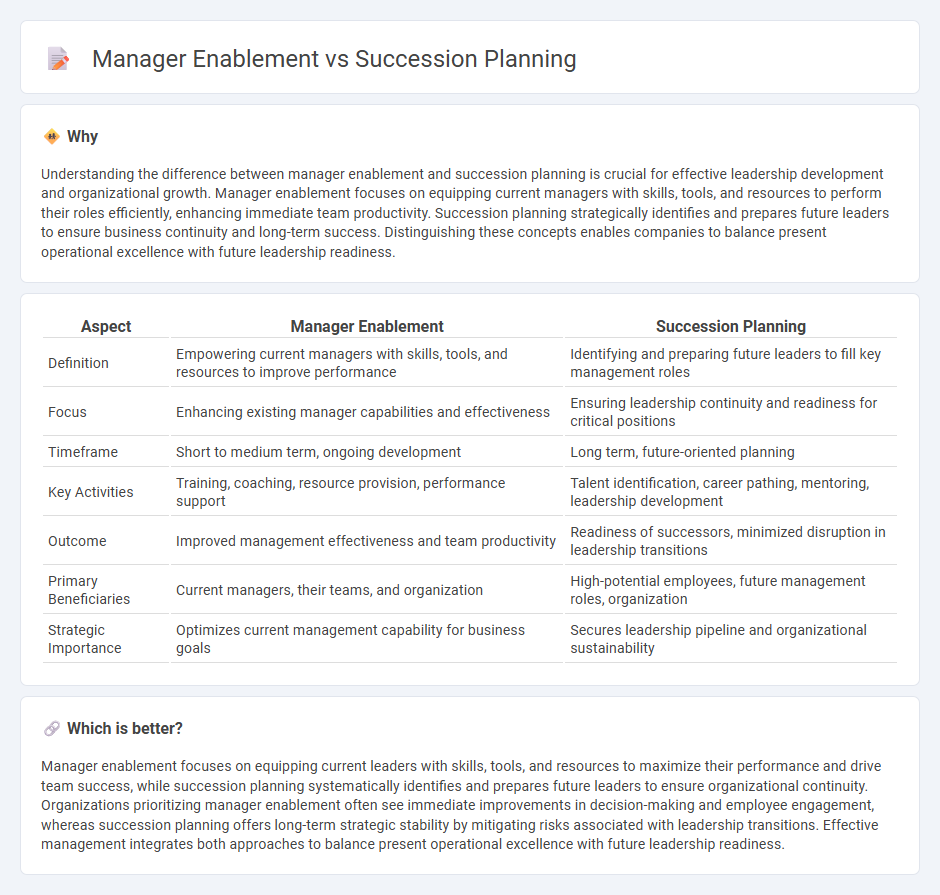
Manager enablement focuses on equipping current leaders with the skills, tools, and resources needed to enhance performance and drive team success, while succession planning strategically prepares potential candidates to seamlessly fill key leadership roles in the future. Companies investing in manager enablement see improved decision-making and employee engagement, whereas effective succession planning reduces organizational risk by ensuring leadership continuity. Explore how integrating both strategies can strengthen your leadership pipeline and secure long-term business growth.
Why it is important
Understanding the difference between manager enablement and succession planning is crucial for effective leadership development and organizational growth. Manager enablement focuses on equipping current managers with skills, tools, and resources to perform their roles efficiently, enhancing immediate team productivity. Succession planning strategically identifies and prepares future leaders to ensure business continuity and long-term success. Distinguishing these concepts enables companies to balance present operational excellence with future leadership readiness.
Comparison Table
| Aspect | Manager Enablement | Succession Planning |
|---|---|---|
| Definition | Empowering current managers with skills, tools, and resources to improve performance | Identifying and preparing future leaders to fill key management roles |
| Focus | Enhancing existing manager capabilities and effectiveness | Ensuring leadership continuity and readiness for critical positions |
| Timeframe | Short to medium term, ongoing development | Long term, future-oriented planning |
| Key Activities | Training, coaching, resource provision, performance support | Talent identification, career pathing, mentoring, leadership development |
| Outcome | Improved management effectiveness and team productivity | Readiness of successors, minimized disruption in leadership transitions |
| Primary Beneficiaries | Current managers, their teams, and organization | High-potential employees, future management roles, organization |
| Strategic Importance | Optimizes current management capability for business goals | Secures leadership pipeline and organizational sustainability |
Which is better?
Manager enablement focuses on equipping current leaders with skills, tools, and resources to maximize their performance and drive team success, while succession planning systematically identifies and prepares future leaders to ensure organizational continuity. Organizations prioritizing manager enablement often see immediate improvements in decision-making and employee engagement, whereas succession planning offers long-term strategic stability by mitigating risks associated with leadership transitions. Effective management integrates both approaches to balance present operational excellence with future leadership readiness.
Connection
Manager enablement enhances leadership capabilities by providing training, resources, and decision-making authority that prepare managers for advanced roles. Succession planning relies on a pipeline of empowered managers who possess the skills and experience needed to seamlessly assume critical positions. Together, these strategies ensure organizational continuity and stability by aligning talent development with future leadership requirements.
Key Terms
Succession Planning:
Succession planning involves identifying and developing internal talent to ensure leadership continuity and minimize disruptions during key transitions. It emphasizes long-term strategic talent management by preparing high-potential employees for future leadership roles through targeted training and development programs. Explore more to understand how effective succession planning drives sustainable organizational growth.
Talent Pipeline
Succession planning emphasizes identifying and developing high-potential employees to fill key leadership roles, ensuring a robust talent pipeline for future organizational stability. Manager enablement focuses on equipping current managers with the skills, tools, and resources needed to lead teams effectively and foster employee growth. Explore how integrating these strategies can optimize your talent pipeline and drive long-term business success.
Leadership Development
Succession planning ensures seamless leadership transitions by identifying and preparing high-potential employees for future roles, emphasizing long-term organizational stability. Manager enablement focuses on equipping current leaders with skills, tools, and resources to enhance their performance and drive team success. Explore comprehensive strategies to balance both for optimal leadership development.
Source and External Links
Succession Planning: All You Need To Know [2025 Edition] - AIHR - Succession planning is the process of selecting and developing key talent to ensure continuity of critical roles through a model that identifies, assesses, and develops future leaders step-by-step.
Succession Planning: 7-Step Guide & Template - Paylocity - Succession planning is a long-term strategy to identify and train employees for key roles in advance, enhancing business continuity, retention, and diversity through a transparent and inclusive process.
Succession planning - Wikipedia - Succession planning is a process and strategy for preparing internal candidates with leadership potential to fill critical business roles and ensure smooth leadership transitions, including in family businesses with advisor support.
 dowidth.com
dowidth.com